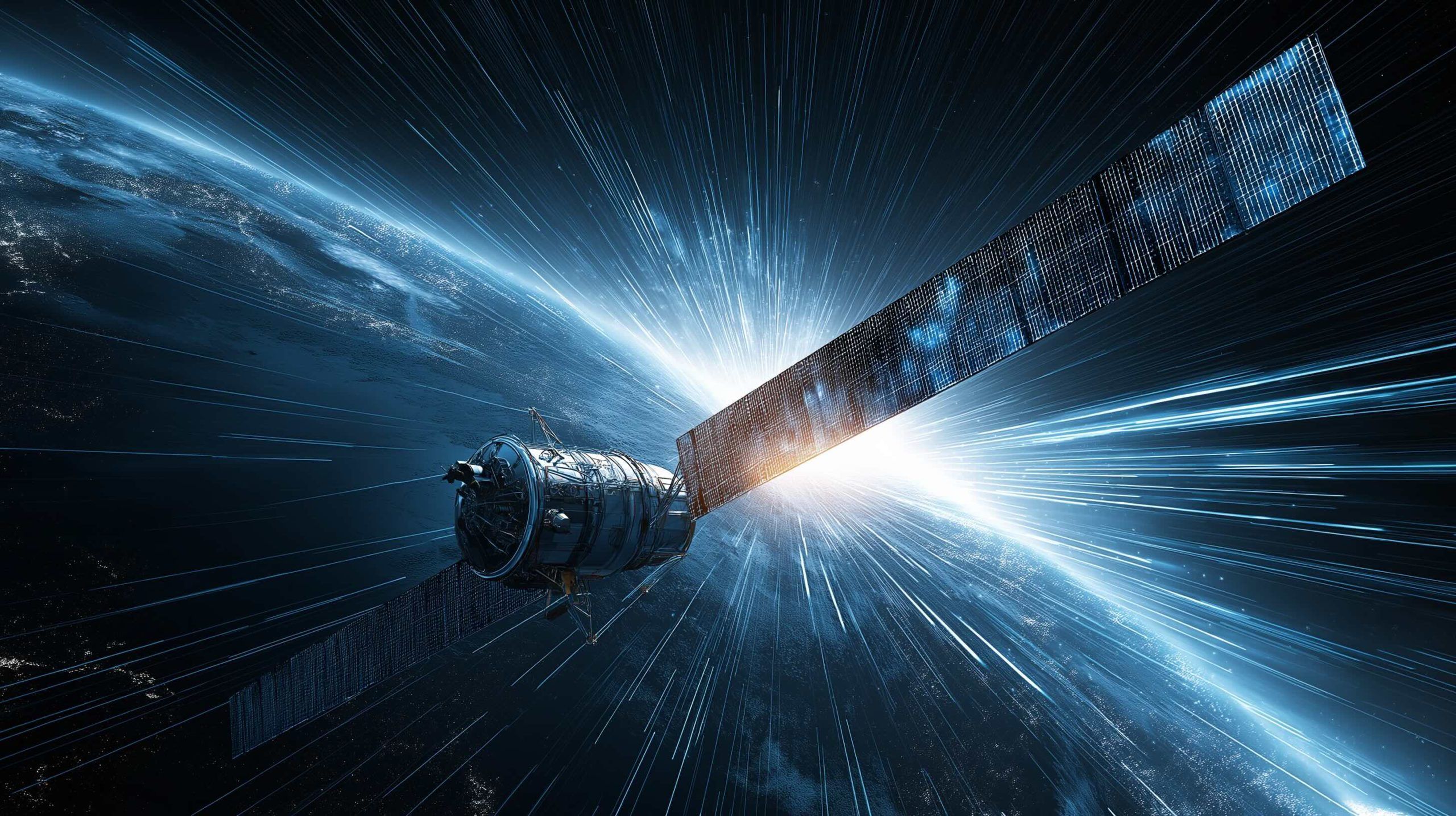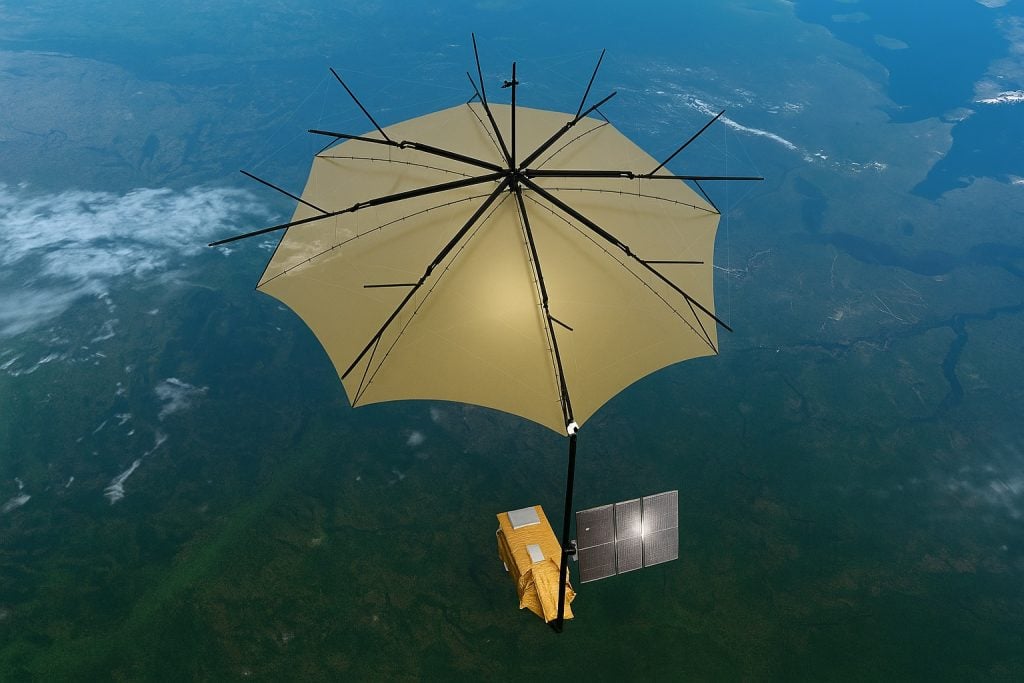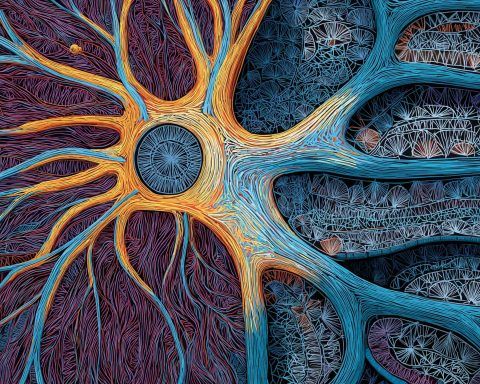- The ROQuET payload, a photonic quantum computer no larger than a shoebox, was developed by Philip Walther’s team at the University of Vienna and measures about 15 × 15 × 45 cm, weighing roughly 9.5 kg with an aluminum frame and a borosilicate glass optical circuit.
- The device was launched on June 23, 2025, aboard SpaceX’s Transporter-14 mission and hosted on D-Orbit’s ION platform as the SCV004 Upmik payload.
- The Falcon 9 rocket lifted off from Vandenberg Space Force Base and deployed around 70 satellites into a sun-synchronous orbit at about 550 km altitude.
- The mission demonstrates edge computing, enabling the photonic processor to perform data analysis on-board rather than downlink raw data to Earth.
- The quantum processor consumes less than 30 watts of power, making it highly suitable for solar-powered spacecraft.
- It is designed to operate without special cooling or vacuum beyond what space provides, using passive optical components that are radiation-hard.
- First data from the payload is expected roughly one week after launch as part of a short commissioning sequence.
- In wildfire monitoring, the system could detect fires on-board and transmit only the location-identified results, reducing downlink bandwidth needs.
- For secure space communications, the mission discusses using quantum-generated randomness for one-time pads and developing quantum key distribution links, citing the Micius 2017 demonstration.
- Looking ahead, NASA is exploring quantum computing for autonomous deep-space navigation, with the DNAV (Deep Space Navigation) co-passenger payload and concepts like a quantum astrogator to improve in-space guidance.
Space-Based Quantum Revolution – In a historic milestone for space and quantum technology, a photonic quantum computer no larger than a shoebox has been launched into Earth orbit. Riding aboard SpaceX’s Transporter-14 mission on June 23, 2025, this miniature quantum processor – the first of its kind in space – promises to rewrite how satellites handle data [1] [2]. Developed by an international team led by physicist Philip Walther at the University of Vienna, the device is designed to withstand the harsh environment of orbit while performing advanced computations on-board. This breakthrough could enable satellites to analyze imagery and sensor information in real-time, beaming down insights instead of raw data, and it foreshadows profound impacts on wildfire monitoring, secure communications, and even deep-space exploration.
Built for Space: Inside the Photonic Quantum Satellite
Designing a quantum computer for space meant shrinking an entire optics lab to shoebox dimensions and ruggedizing it for launch. The result measures about 15 × 15 × 45 cm and weighs ~9.5 kg [3]. Its frame is aluminum, housing an optical circuit made of borosilicate glass, with fiber-optic cables, lenses, mirrors, and even a titanium-mounted single-photon source carefully packed inside [4]. Impressively, the system consumes <30 watts – far less power than most classical computers, a huge advantage for a satellite limited to solar energy [5]. Walther’s team had just 11 working days in a cleanroom to assemble the flight model, integrating expertise in quantum optics, electronics, software, and aerospace engineering [6] [7]. “The working atmosphere was extremely tense – we only had eleven days to build the flight model from scratch,” recalls team member Simon Steiner [8].
Such tight timelines were met by creative problem-solving. In one anecdote, researchers 3D-printing a component in Germany realized they forgot a power cable – and ended up buying a toaster at a local store just to cannibalize its cord for the printer [9]. The team’s dedication paid off: the fully functional quantum payload passed rigorous tests for vibrations, radiation, and temperature extremes [10] [11]. Traditional quantum computers (like those using trapped ions or superconducting qubits) require ultra-stable, cryogenic conditions, but this photonic processor thrives without any special cooling or vacuum beyond what space naturally provides [12]. Walther notes that light-based quantum hardware is inherently suited for space – photonic systems can be made lighter, smaller, and more robust than other architectures, with no delicate electromagnetic traps or nanokelvin refrigeration needed [13]. In fact, the Vienna-built device is so sturdy that “it can quite literally be thrown from the fifth floor” and still work, Walther quips [14]. This resiliency is critical for surviving rocket launch g-forces and the +70°C to –30°C temperature swings the satellite will experience in sunlit vs. shadowed orbits [15].
Mission Profile: SpaceX Transporter-14 and the ION Platform
SpaceX’s rideshare Transporter-14 mission carried this pioneering payload to orbit as part of a packed manifest. The Falcon 9 rocket lifted off from Vandenberg Space Force Base in California, deploying around 70 satellites and capsules into a sun-synchronous orbit about 550 km above Earth [16] [17]. The quantum computer is hosted on D-Orbit’s ION satellite platform, essentially a modular orbital carrier that can house and release multiple payloads. In this case, the ION vehicle (nicknamed “SCV004 Upmik”) not only released several cubesats but also serves as a space-borne laboratory carrying the quantum computing experiment (termed ROQuET – Reconfigurable orbital Quantum Computing for Earth observation Technology) [18]. Despite its diminutive size, the quantum device stood out among fellow passengers that included a radar imaging satellite (Capella-17), a space tug experiment (Starfish Space’s Otter Pup), and even a capsule carrying human DNA and ashes (Celestis/Nyx) [19].
Orbit insertion and operations: After a nearly two-hour deployment sequence and a successful booster landing (marking the Falcon 9’s 26th flight) [20] [21], the ION vehicle began phasing into its targeted orbit. The quantum computer’s systems were scheduled to power up and undergo checkouts, with the first data expected about one week after launch [22] [23]. This short commissioning timeline underscores the plug-and-play nature of the photonic payload – there’s no lengthy calibration for cryogenics or vacuum systems as with other quantum tech. Communication with the satellite will downlink not raw experimental data but the results of on-board computations, a key feature we explore below. The mission is both a technology demo and a stress test: how long can this quantum hardware run reliably in orbit’s radiation and microgravity? “This mission allows us to test the performance and durability of quantum hardware under extreme conditions – we can investigate how long they remain functional in the harsh environment of space,” Walther explained [24]. The team hopes to operate the quantum computer for several years, gathering data on any degradation of its optics or detectors under cosmic rays [25]. Importantly, the entire ION spacecraft (and attached quantum payload) is not intended to become space junk – once the mission concludes, it will deorbit in a controlled re-entry, burning up in the atmosphere [26]. This ensures a clean demonstration, literally and figuratively, paving the way for future quantum satellites.
On-Board Quantum Algorithms and Edge Computing Advantages
At the heart of this orbital experiment is the concept of edge computing – performing data processing on the satellite itself, rather than sending everything down to Earth. The photonic quantum processor is essentially a micro lab for light-based computation: it can capture images of Earth using an onboard camera, then feed the data (as photons) into its optical circuit for analysis [27]. By exploiting the quantum properties of these photons – interference, diffraction, superposition – the processor can perform certain calculations ultra-efficiently in analog. In practice, the device is set up to execute operations like Fourier transforms and convolutions optically [28]. Those mathematical routines are the bread-and-butter of image processing and machine learning algorithms – used for filtering images, detecting features, and pattern recognition. Thanks to the physics of light, an optical interferometer can perform a complex Fourier transform essentially at the speed of light just by how a lens bends the light waves, something that would take significant time and power on a classical computer [29]. The analog nature of this photonic computer means it isn’t qubit-based in the same way as, say, a superconducting quantum computer; rather than discrete logic gate operations, it uses continuous optical processes to solve equations. This makes it exceptionally suited for tasks like real-time signal/image processing where the input is naturally an optical image or waveform.
Crucially, processing data on-board mitigates one of satellite computing’s biggest bottlenecks: the downlink. “It enables edge computing, meaning the data is processed directly on the satellite,” the Austrian team explains – saving time and energy since raw data no longer needs to be sent via limited bandwidth to ground stations [30]. Instead of downlinking, for example, a large high-resolution image and waiting for ground analysts to examine it, the satellite can analyze that image in situ and transmit only the useful insight (a tiny packet) to Earth. This approach “drastically reduces energy use and improves response time,” turning hours or days of data relay into near-instant results [31]. Walther emphasizes that this is a game-changer: “That’s the big trick. The more you can already process up there [on the satellite], the better off you are,” he said [32]. In other words, satellites will become smarter and more autonomous, not just blind cameramen feeding an insatiable pipeline to Earth.
Wildfire Monitoring: Quantum Edge for Early Detection
One of the headline applications for this technology is real-time wildfire monitoring from orbit – a pressing need in an era of mega-fires and climate change. Traditional Earth observation satellites like NASA’s MODIS or Landsat periodically scan forests and wildlands, but raw images often take time to downlink and analyze. By the time analysts identify a nascent wildfire hotspot in the data, precious hours may have passed. A quantum-equipped satellite can change that. Forest fire detection can be done on-board, at the point of capture, thanks to edge processing [33]. As soon as the satellite’s infrared camera spots a suspicious hot pixel or smoke plume, the photonic processor can run a convolutional neural network or spectral analysis to confirm it’s a fire and not a false alarm. Within the same orbital pass, the satellite could then transmit an alert (with location coordinates) directly to firefighting authorities on the ground. This could save valuable time in the early detection of wildfires, potentially containing an outbreak before it spreads [34] [35].
Consider that large wildfires can grow exponentially within hours; speeding up detection even by 30–60 minutes can make a huge difference in emergency response. Edge computing also means energy savings on the satellite – it doesn’t have to beam down entire high-res images (which strain both onboard power and ground station schedules), only the “fire detected at lat/long X” message. The University of Vienna team explicitly demonstrated this use-case: the quantum computer can analyze sensor data for fire signatures and deliver the analysis result – e.g. the detection of a forest fire – directly to Earth [36]. In effect, the satellite becomes an AI eyes-in-the-sky, not only seeing but thinking about what it sees. Beyond wildfires, the same capability can apply to other natural disasters or environmental events – spotting volcanic eruptions, flooding, algal blooms, or even illegal deforestation in progress, all without waiting for data downloads. “Our findings can contribute to Earth observation and climate research,” Walther noted, pointing to the broad utility of having intelligent orbiting sensors [37].
Encryption and Secure Space Communications
Edge quantum computing in orbit also carries implications for encryption and satellite security. Today’s satellites rely on classical encryption to secure the terabytes of data they send to Earth (as well as command uplinks controlling the spacecraft). However, the future arrival of large-scale quantum computers poses a threat: much of current encryption (e.g. RSA, Diffie-Hellman) could be cracked by Shor’s algorithm on a sufficiently powerful quantum machine [38]. Space assets, which often stay in service for decades, are especially vulnerable to this upcoming “Y2Q” (Years to Quantum) problem – a spy agency could record their encrypted transmissions now and decrypt them later once quantum hacking becomes feasible [39]. This is driving interest in quantum-resistant cryptography and quantum cryptography for space communications. Notably, SpaceX is already researching Quantum Key Distribution (QKD) to secure data links between satellites and ground stations [40]. QKD uses the laws of quantum physics to generate encryption keys that are provably secure – any eavesdropper trying to intercept the key will inevitably disturb the quantum signals and be detected. In 2017, China demonstrated the power of this approach with its Micius quantum science satellite, achieving the first intercontinental quantum-encrypted video call between Vienna and Beijing [41] [42]. Micius distributed secret keys by beaming down entangled photons to two distant ground stations; if a hacker tried to tap those photons, their quantum state would collapse, revealing the intrusion [43] [44]. This made the communication “virtually unhackable” according to scientists – an early glimpse of a space-enabled quantum internet [45].
For the new photonic quantum satellite, secure communications could play a dual role. First, the satellite itself can benefit: it could use a quantum-generated random number as a one-time pad to encrypt its own downlinked data, ensuring that even a future code-breaker can’t retroactively decrypt the information. Photonic quantum computers are naturally good random number generators (due to inherent quantum uncertainty), so the device can supply its own cryptographic-grade entropy on demand. Second, this mission lays groundwork for quantum communication nodes in orbit. A next-generation version might perform entanglement distribution or QKD with other satellites or ground receivers, extending quantum-secure networks globally. Space-based quantum computers might even run encryption algorithms that are quantum-safe as part of their on-board processing, packaging results with post-quantum cryptography before transmission. As satellites increasingly handle sensitive data – from military communications to climate monitoring vital to nations – quantum edge computing will help keep those links secure against evolving threats. In the words of one aerospace encryption expert, “quantum cryptography is a fundamentally new way to give us unconditional security ensured by the laws of physics.” [46] Combining that with on-board processing means future satellites could autonomously decide when to initiate a quantum key exchange or switch ciphers, without needing ground intervention, thus making space communications both smarter and safer.
Deep-Space Probes: Autonomy Powered by Quantum Computing
Looking further ahead, the success of this photonic quantum computer in low Earth orbit hints at big possibilities for deep-space probes and interplanetary missions. Spacecraft venturing to the Moon, Mars, and beyond face extreme communication delays and limited bandwidth – a Mars rover, for instance, must send data over tens of millions of kilometers, with a single image taking minutes to transmit and ~20-minute one-way delays for instructions. Edge computing is almost a necessity for deep-space exploration, and adding quantum capabilities could supercharge a probe’s autonomy and scientific output. By carrying quantum processors, future probes could locally crunch complex datasets or optimize decisions without waiting for Earth. For example, a quantum computer on a Jupiter orbiter could rapidly analyze spectrometer readings for signs of life chemistry on Europa’s surface, or optimize its own trajectory in real-time to fly through a sudden plume from a moon. In fact, NASA has already begun exploring quantum computing for space navigation and mission planning: “NASA is tackling [deep space navigation] by experimenting with quantum-enhanced GPS systems,” leveraging quantum algorithms to improve the precision of positioning far from Earth [47]. Faster processing of star tracker data or pulsar signals via quantum algorithms might allow a spacecraft to pinpoint itself autonomously in the void, an idea sometimes called a “quantum astrogator.”
Intriguingly, the Transporter-14 mission itself carried an experiment pointing in this direction. One of the co-passenger payloads was “DNAV (Deep Space Navigation)” by a European startup, which is an AI-powered processor designed to let satellites navigate independently using a starfield camera and onboard image processing [48]. That classical system, combined with a high-performance AI chip, aims to free probes from relying on Earth-based tracking – and it underscores a trend: spacecraft are getting smarter about managing their own guidance and data. Add quantum computing into the mix, and you have the ingredients for a truly self-sufficient probe. A sufficiently advanced quantum computer could solve complex optimization problems for spacecraft, like plotting fuel-efficient orbital insertions or performing science data compression beyond what classical methods allow. (Quantum algorithms have shown promise in optimizing routes and solving scheduling puzzles much faster than traditional code [49] [50] – think of applying that to a multi-target flyby tour of the outer planets.) Moreover, quantum sensors paired with on-board quantum computing could enable experiments probing fundamental physics (e.g. testing quantum entanglement in deep space, or searching for gravitational wave signals) without needing continuous ground supervision.
Of course, there are major challenges to address before quantum computers voyage to the outer planets. They must be incredibly reliable against cosmic radiation, operate in extreme cold or heat, and remain stable over years of cruise – challenges that this first mission in low orbit will help evaluate. The photonic design from Vienna is a promising candidate since it uses passive optical components (lenses, beam splitters) that are inherently radiation-hard and require no cooling [51]. If it continues to function in orbit for months and years, that will boost confidence in scaling up the approach. “This project has turned us into a space group,” Walther said after the launch, noting that the team gained expertise to pursue more ambitious space experiments going forward [52] [53]. It’s easy to imagine a constellation of quantum microsatellites in the future, each processing data from different regions of Earth, or a quantum co-processor aboard a Mars orbiter working alongside AI systems to decide which findings to radio back. The European Space Agency and NASA are already funding studies on quantum computing for spacecraft and quantum communication networks in space, seeing these technologies as key enablers for autonomous deep-space habitats and missions in the coming decades [54] [55].
Conclusion: A New Era of Smarter Space Missions
By successfully launching a photonic quantum computer into orbit, scientists have opened the door to a new era where spacecraft can analyze, decide, and adapt in real-time. This first-of-its-kind satellite is proving that quantum computers don’t have to stay tethered to labs with delicate infrastructure – they can ride piggyback to space and operate amid vacuum and cosmic rays. The immediate payoff will be satellites that can think on-site, whether it’s spotting wildfires as they ignite or compressing encrypted data to send to ground. In the near future, as the technology matures, we can expect “quantum eyes” in the sky that not only see the Earth in new ways but also keep our communications secure through unbreakable encryption protocols. And as humanity pushes further out into the solar system, quantum computing at the edge will be an invaluable ally – helping deep-space probes navigate and perform science with a level of intelligence and efficiency previously unimagined.
The launch on Transporter-14 is therefore more than just a cool science experiment; it’s a proof-of-concept for the ultimate smart satellite. “This mission strengthens Europe’s and Austria’s pioneering status in quantum research,” Walther said [56], highlighting the global significance of taking quantum tech to the final frontier. From climate monitoring to secure communications and interplanetary travel, the implications of orbital quantum computers are vast. As one report put it, orbiting a quantum processor at 550 km is a “groundbreaking quantum leap” that could transform how space missions handle data [57]. The lessons learned now – in hardware resiliency, software algorithms, and operational integration – will directly inform the design of next-generation satellites and probes. In the coming years, don’t be surprised if both commercial and scientific spacecraft begin to sport their own built-in quantum co-pilots. The age of edge computing in space has dawned, and it’s quantum. 🚀🛰️
Sources: Recent reports and press releases on the Transporter-14 quantum satellite launch and expert commentary on quantum computing applications in space [58] [59] [60] [61] [62], including statements from Prof. Philip Walther’s team at University of Vienna and analysis by Digital Watch, Interesting Engineering, APA Science, and others. All details are sourced from June 2025 updates on this mission and related space-tech developments. [63] [64]
References
1. interestingengineering.com, 2. dig.watch, 3. rudolphina.univie.ac.at, 4. rudolphina.univie.ac.at, 5. rudolphina.univie.ac.at, 6. science.apa.at, 7. science.apa.at, 8. rudolphina.univie.ac.at, 9. rudolphina.univie.ac.at, 10. unn.ua, 11. science.apa.at, 12. www.dorbit.space, 13. science.orf.at, 14. rudolphina.univie.ac.at, 15. science.orf.at, 16. interestingengineering.com, 17. dig.watch, 18. www.dorbit.space, 19. interestingengineering.com, 20. interestingengineering.com, 21. interestingengineering.com, 22. unn.ua, 23. interestingengineering.com, 24. interestingengineering.com, 25. science.orf.at, 26. rudolphina.univie.ac.at, 27. rudolphina.univie.ac.at, 28. interestingengineering.com, 29. interestingengineering.com, 30. science.apa.at, 31. dig.watch, 32. science.orf.at, 33. dig.watch, 34. www.linkedin.com, 35. dig.watch, 36. science.apa.at, 37. interestingengineering.com, 38. www.iotinsider.com, 39. www.iotinsider.com, 40. patentpc.com, 41. www.sciencenews.org, 42. www.sciencenews.org, 43. www.sciencenews.org, 44. www.sciencenews.org, 45. www.sciencenews.org, 46. www.sciencenews.org, 47. patentpc.com, 48. www.dorbit.space, 49. patentpc.com, 50. patentpc.com, 51. www.dorbit.space, 52. interestingengineering.com, 53. interestingengineering.com, 54. patentpc.com, 55. www.sciencenews.org, 56. science.apa.at, 57. dig.watch, 58. interestingengineering.com, 59. dig.watch, 60. science.orf.at, 61. patentpc.com, 62. www.sciencenews.org, 63. interestingengineering.com, 64. science.apa.at










